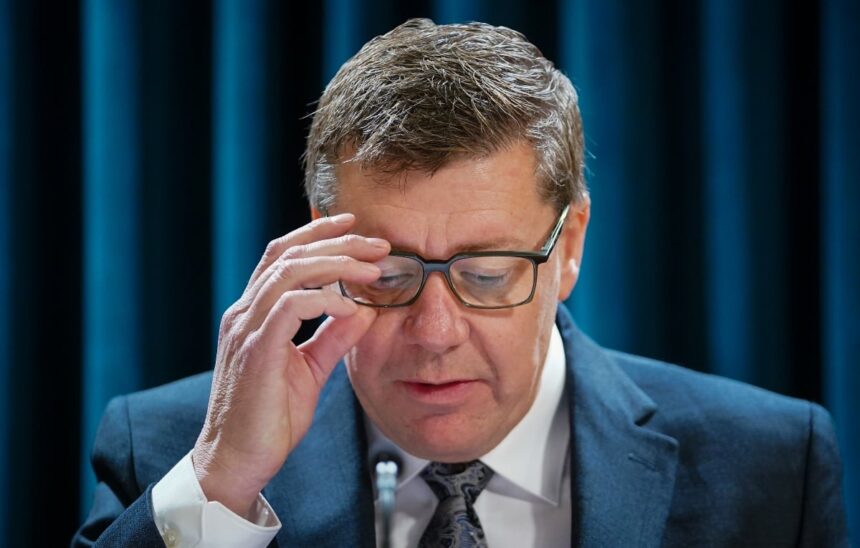The smell of smoke hangs over much of Saskatchewan’s northern region this week, as Premier Scott Moe declared a state of emergency yesterday afternoon. Standing beside grim-faced emergency officials, Moe delivered the news many residents had feared was coming.
“We’re facing an unprecedented wildfire situation that has already forced over 8,000 residents from their homes,” Moe said during Wednesday’s press conference in Regina. “Our firefighting resources are stretched to their absolute limits.”
The fires, which began last weekend after lightning strikes hit bone-dry forests north of Prince Albert, have now consumed over 150,000 hectares. Provincial officials confirm this is already the largest May wildfire event in Saskatchewan’s recorded history.
In La Ronge, community coordinator Brenda McKenzie hasn’t slept more than three hours a night since evacuation orders came down. “We’ve got elders who need medical support, families with nowhere to go, and the smoke is so thick you can barely see across the street,” she told me during a phone call as she coordinated buses leaving town.
Behind the immediate crisis lies a troubling pattern. Saskatchewan’s wildfire season has started progressively earlier each year since 2020. Environment Canada data shows the province experienced its driest April in 45 years, creating perfect conditions for the current disaster.
“What we’re seeing isn’t just bad luck,” says Dr. Warren Mabee, Director of the Institute for Energy and Environmental Policy at Queen’s University. “Climate models have predicted exactly this pattern of earlier, more intense fire seasons across the boreal forest region.”
The provincial response includes over 400 firefighters, with reinforcements requested from neighboring provinces. Six water bombers are operating at capacity, according to Saskatchewan Public Safety Agency spokesperson Jeff Bent. The Canadian Armed Forces has deployed two Hercules aircraft to assist with evacuations from remote communities.
At a hastily established evacuation center in Saskatoon’s SaskTel Centre, I met Thomas Morin, who fled his home in Stanley Mission with just a suitcase and his family photos. “This is the third time we’ve had to leave in five years,” he said, his voice steady but eyes reflecting exhaustion. “Each time, it gets harder to rebuild.”
The provincial government has allocated $25 million in emergency funding, but critics question whether Saskatchewan’s wildfire management approach has kept pace with changing climate realities. Last year’s provincial budget actually reduced wildfire prevention funding by 12 percent, according to public accounts documents.
NDP Opposition Leader Carla Beck called the current crisis “heartbreaking but predictable” during a media scrum Thursday morning. “We’ve been warning about inadequate prevention measures and firefighting resources for years,” Beck said. “Now we’re paying the price in lost homes and displaced families.”
For Indigenous communities, who make up nearly 80 percent of those evacuated, the fires represent more than just property damage. Buffalo River Dene Nation Chief Norma Catarat emphasized the deeper impacts during an emergency tribal council meeting in Prince Albert.
“These aren’t just houses burning. These are our traditional territories, places where we hunt, trap, and gather medicines,” Catarat explained. “When these forests burn, we lose part of our identity and ways of being that have sustained us for generations.”
The evacuation has stretched provincial resources thin. Red Cross officials report that emergency shelters in Prince Albert, Saskatoon, and Regina are approaching capacity. The province has issued calls for hotels and motels to provide additional temporary housing.
Saskatchewan’s wildfire emergency fits into a troubling national pattern. Statistics Canada reports that wildfire seasons across Canada have lengthened by nearly three weeks on average since the 1970s. Last year’s record-breaking fire season saw over 15 million hectares burn nationwide.
Federal Emergency Preparedness Minister Bill Blair announced additional support Thursday morning, including $8 million in immediate disaster relief. “We stand ready to provide whatever assistance Saskatchewan needs during this difficult time,” Blair said during a virtual press conference.
For meteorologists, the conditions fueling these fires weren’t unexpected. “We’ve been watching this disaster develop in slow motion,” explains Environment Canada meteorologist Terri Lang. “The combination of below-average snowpack, early spring melt, and weeks without significant rainfall created perfect fire conditions.”
Back in Prince Albert, where the evacuation center’s gymnasium floor is covered with cots, I met Sarah Sanderson, a nurse who’s volunteering after her 12-hour hospital shifts. “These folks have been through so much trauma already,” she said, helping an elderly man with his medication. “The least we can do is make sure they feel safe and cared for now.”
Provincial officials warn the situation may worsen before it improves. Weather forecasts show no significant rainfall for at least another week, with temperatures expected to remain above seasonal averages.
For residents like James Natomagan from Pelican Narrows, the future feels uncertain. “This is our home, but I wonder if we’ll be doing this every summer now,” he said, watching his children play with donated toys at the evacuation center. “At some point, you start wondering if you can keep rebuilding.”
As night fell over Saskatoon, the orange glow of distant fires was visible on the northern horizon – a sobering reminder that Saskatchewan’s battle with wildfire is far from over.






